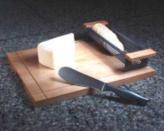|
|
|||||||||
By Val Kraev
Editor's note: Kraev's Korner was first published in the newsletter of the Altshuller Institute in 2005. Our thanks to the Altshuller Institute and the Technical Innovation Center for letting us reprint this educational series. Previous lessons can be found by searching the TRIZ Journal's archives.
Classical TRIZ proves that technical systems evolve in predictable patterns. As part of TRIZ, the system evolution module searches for possible solutions for technological problems. It also explores possible evolutionary trends for a developed system or product. These trends are based on a forecast of ways in which technological systems historically develop.
Investigations into the patterns of technical systems evolution was conducted by Genrich Altshuller and his colleagues starting in early 1970s. These explorations were based on reviewing a massive amount of patent information and certain natural general laws, specifically laws of dialectics. Eight evolution patterns were discovered that help engineers predict the most likely improvements for a developed product. Here are these patterns of evolution:
Sometimes in inventive literature these patterns are called "lines" or "trends" of evolution. Altshuller named these trends "laws" and classified them in three groups, which are called:
Static trends describe the period of birth and forming of the technical system; kinematics trends define the period of a system's growth and flowering; dynamics trends are related to concluding period of a system's development and transition to a new system. (Altshuller published this list in 1979. The trend of dynamization was included later, in 1986.) Technical systems follow these general trends. From the initial system to multiple improvements, the system always moves toward ideality until it reaches exhaustion of the existing technology and system resources. Trends are used as a forecasting tool and for failure analysis for the development and evolution of technical system.
How can we use predictable patterns in practice? The patterns have broad ways for developing future effective systems. Two simple steps to use the patterns of evolution are:
The simplest way to proceed is to review each of the patterns while trying to apply of each – or their combinations – to solving a concrete problem.
|
Dynamization Consider the evolution or sports footwear through dynamization. According to this pattern, the technical systems (as a rule) start the development from monolithic structure evolving through several consistent stages: monolithic structure » articulated structure » completely flexible structure » gas or liquid structure » field structure. The simplest footwear represented monolithic (unchangeable) structure, composed of a solid sole and a canvas upper part with laces. Despite the relative simplicity of such footwear, its deficiency was rapid wear, minimum cushioning for feet, the shoe lacked any fashion sense and was unsuitable for anything besides sports activity. Moreover, different shoes were required for different activities. For instance, for jogging the shoe should be light and resilient but for soccer the shoes should be relatively solid and designed with good traction for grass fields.
At the next stage of evolution the monolithic structure is transformed to a structure with one, or several, mobile joint(s) among its components. An example of such development is the footwear of the Marshmallow Skin company. This "interchangeable" footwear consists of one sole and set of four different color uppers, which connect to the sole by a zipper. The company states that one pair of their shoes is like having four pairs of shoes. Thus, if you were bothered by orange color, you can simply change it to blue, yellow or violet. In the beginning, these shoes were developed for young girls but now such footwear also is very popular among adults and the company increased sales of larger-size shoes. Thanks to this articulated structure, this product has a wide range of designs and functions.
Evolving further, the system is transformed from the articulated structure toward completely flexible structure. "Max the Worm" shoes for children are another example of the dynamization pattern. These shoes, designed by sportswear maker K2 Munich, are being tested on cost-conscious German shoppers. By pushing the silver button on the shoe's heel, the concertina panel can be lengthened between the toe and heel to accommodate quickly growing children's feet and bring relief to frustrated parents who want to avoid buying their children countless pairs of new shoes. A spokeswoman for K2, an American firm, said it was targeting Germany where shoppers' keen eyes for a bargain haves been sharpened by economic worries that prompt many to think twice before opening their wallets. This new feature of additional flexibility allows a consumer the ability to quickly change the size of shoes for growing kids.
In the next stage of evolution the sport shoes are inflated with compressed air. Ethylene vinyl acetate (EVA), a substance made up of millions of tiny air bubbles that provides cushioning and absorbs shock, was developed in the 1970s. It was considered a major advance in footwear technology and is still widely used today. Probably the most famous cushioning system comes from Nike who developed the very popular Nike Air shoe – with an air cushioned sole. Introduced in 1979, Nike Air was one of the first trainers to incorporate an air bubble into the heel of the shoe. Another elegant example for this evolution stage is Dr. Martens Airware Shoes. In 1945, Dr. Martens injured his foot in a skiing accident in the Bavarian Alps. To facilitate walking during the healing process, he designed a shoe with an air-cushioned sole. By using old rubber tires, he constructed a sole that had air trapped within a closed compartment. At first many manufactures rejected the concept of an air-cushioned sole as a temporary gimmick. However a little-known English company, R. Griggs Group, decided to embrace the idea. Now shoes from Dr. Martens are classics. (Note – this company began to use an air-cushioned sole not only in sport footwear but in usual shoes as well. Applying compressed air inside the shoe structure is a typical stage of dynamization. It gives the consumer an excellent effect of softness and comfort. Wearing this footwear provides greater comfort and less fatigue during long periods of use. Adidas first presented jogging shoes with a built-in digital computer, capable of changing dynamically the stiffness of the sole depending on current conditions and preferences of the wearer. Sport shoes were developed at the American Adidas subdivision during three years in an atmosphere of strict confidentiality. The new model received a very simple title, Adidas 1. The computer-based control system regulates the level of sole cushioning at each step and defines a degree of its deformation. The sensor located under the heel measures distance between the upper and lower sole parts. In one second, the sensor makes more than 1,000 measurements to within 0.1 mm. All data is calculated by a microprocessor that is capable of executing 5 millions calculations per second. By means of a mechanical drive unit, the dynamic cushion is constantly tuned. Another, similar electronic footwear, Verb for Shoe, was developed by VectraSense Technologies. This adaptive footwear is capable of recognizing the style of walking or running of the wearer and storing his preferences. Application of an electrical control field inside footwear structure is an example of the field stage of dynamization that satisfied new complicated consumer requirements. It became possible to develop intelligent and self-adapted shoes for varying requirements. |
|
Transition From Macro- to Micro- Level We shall consider the development of tools for tooth cleaning through the transition from macro- to micro-level. According to this trend, the technical system's evolution starts from a single structure developing through several predictable stages: single » segmented » liquid or powder » gas or plasma » field. An ordinary modern instrument for oral care is the toothbrush. The usual brush has a handle for the hand and bristles for cleaning teeth and gums. This brush structure is adequate for cleaning your teeth, but it is not the ideal shape. Many inventors, therefore, tried to develop better instruments for cleaning teeth and gums. We shall look at the bristles development only through the TRIZ pattern of transition from macro- to micro-level.
In accordance with this pattern, the first transformation is focused on transitioning from a single to a segmented structure. Therefore, one option is to divide the brush bristles into several parts. This type of brush has proven more effective than standard toothbrushes in fighting plaque and reducing gum disease in hard to reach areas and the interior gum line. It features an advanced three-sided design that surrounds the teeth and positions the bristles at the professionally recommended 45 degree angle. There is an additional benefit – the tongue scraper is an effective tool in eliminating bad breath. Moreover, the appeal of this kind of toothbrush is not limited to adults; the children's toothbrush enables youngsters to brush correctly without effort or continued parental guidance. Also, for orthodontic patients, it is a good tool for reaching teeth encumbered by braces.
The next transformation of the tool is from a segmented structure to a liquid. The Water Pik has a water jet to reach between teeth and below the gum line to remove debris, plaque and bacteria that cause gingivitis and gum disease. It is quick and easy to use, can be applied with your favorite mouthwash, and leaves your mouth clean and refreshed. The combination of water pressure and pulsation reduces gingivitis, prevents gum disease, superior bacteria removal, massages and stimulates the gums, and is safe on all dental work.
The transition from a liquid tool to a plasma or field structured instrument is the most high-tech transformation. All developments in this stage require special knowledge and experience. Today, many companies propose oral care tools that apply the high-tech phenomena; one such ionic toothbrush is the Soladey-2. This new tool uses the electrochemical reaction of titanium dioxide with light. When exposed to any light source (a fluorescent bathroom light, a plain light bulb or sunlight), the photosensitive titanium rod inside the Soladey-2 converts the light into negatively charged electrons (ions). The rod releases these ions, which blend with our saliva to attract positive (hydrogen) ions from the acid in the dental plaque. The acid is then neutralized and the plaque disintegrates – a scientific approach to a cleaner and healthier mouth! Toothpaste is not required as water (saliva) is the acting ingredient – oral hygiene now becomes not only natural, but very also economical! For those who find it hard to give up toothpaste, use only a very small amount. According to clinical studies, the Soladey-2 can stop plaque buildup. Working with saliva, the brush controls and reduces the bacteria responsible for plaque.
Ultrasonex is another field-structured toothbrush that applies an ultrasonic field with dual frequency. This rechargeable electric tool removes plaque and stains, reduces gum bleeding with the help of ultrasonic action and can be used by adults and children. The brush was invented and patented in the U.S.A. by Dr. R. Bock in the middle of 1990s and was first presented at the international exhibition DentalExpo-2002. A distinctive feature of the ultrasonic cleaning system is that when plaque is subjected to the 1.6 MHz ultrasonic waves of the Ultrasonex brush, these bacterial chains are ruptured – rendering them ineffective. Additionally, ultrasound inhibits the ability of bacteria to adhere to the enamel surfaces of teeth. We can see that during development of the toothbrush the transition from macro- to micro- structured brush bristles takes place. This structure is transformed from a single bristle system to different field structured systems and their combinations. Thanks to the application of these new structures, new consumer requirements are satisfied. |
The patterns of system evolution are an efficient and simple instrument for practical, creative engineering activity. Especially when efficient application of the pattern tools is used to estimate the current condition of a specific product and, certainly, for the prediction of further development of this product. The pattern of increasing ideality of the system remains the basic concept in such work.
The use of the patterns of system evolution is not obligatory, but is recommended. It means that separately taken, a technical system does not evolve necessarily in the order or the stages indicated by the patterns. Sometimes the system skips a stage of pattern of evolution or even on the contrary, the system in the development starts to evolve in opposite direction, for instance from movable to monolithic. We would say it is an exception to the rule. We note, also, that in raising the technological level of a system's evolution, the more elegant the physical phenomenon is used for this purpose and the system's structure becomes more robust.
What we have been discussing is the "classical" TRIZ view of evolutionary trends as defined by Genrich Altshuller. In the last 20 years, there have been some modifications to this list. More current perspectives on this material can be found in TRIZ literature.
The technical systems are developed in according to predictable patterns of evolutions. In TRIZ, more than eight patterns of technical systems evolution were discovered from the analysis of thousands of patents. The knowledge and skill to apply these evolutionary patterns allows for the logical development of new systems at a modern level promptly and efficiently.
Which TRIZ pattern of system evolution is used in the problem solving processes described below?
| Problem Winter is over but we should be prepared for next year. It is unpleasant to go outside in cold weather. Sometimes we cannot walk on sidewalks because they are icy. What to do? Solution Shoe ice treads are like quickly changeable tire chains for your shoes! Four small stainless steel spikes are attached to an adjustable, vulcanized rubber sling that pulls over each shoe. As you walk on ice and snow, those spikes "dig in" to give you extra traction. |
 | Problem Wool gloves are good for our hands at the wintertime. But very often in the street we need to grab keys, pick up change and button our coat. Taking off the gloves for each activity is not convenient. What to do? Solution Convertible gloves have a mitten top that flips back to free your fingers. So, you can grab keys, pick up change and button your coat without taking off the gloves. Designed for maximum warmth and protection, the wool-blend gloves keep your hands comfortable even in the coldest weather. |
 | Knife Problem In order to cut cheese in thin and accurate slices we use a traditional knife. However if the cheese is delicate and soft. and we would like to get slices without damaging its fragile texture, then it is not easy. The same problem arises when we want to cut accurately thin-sized slices of cooked vegetables. So, we need to use something other than a traditional knife. One of the possible solutions for the cutter can be developed from dynamization pattern. |
 | Car's Side Mirror Problem An ordinary car's side mirror cannot give us a full view of outside traffic – there are blind spots. It is possible to turn your head and look at the blind spot but we do not have time and it is dangerous during traffic! Can you propose a simple solution using some patterns of system evolution? |
 | Ground Rodent Problem Keeping gardens and lawns free of destructive ground rodents is a big problem for the country household. Moles, shrews, gophers and other ground rodents are frequent and undesirable visitors for some backyards. Rodents have poor eyesight, yet nature has given them a very acute sense of hearing. Can you use those features to propose some solutions using field-structured tools? |
Val Kraev is the chief TRIZ officer of the Technical Innovation Center in Worcester, MA, USA, and has contributed several very valuable case studies to The TRIZ Journal. Contact Val Kraev at kraev (at) triz.org or visit http://www.triz.org.